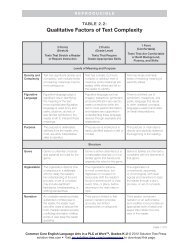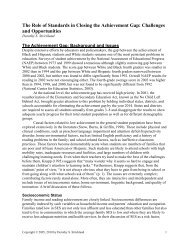Global Education Digest 2012 - International Reading Association
Global Education Digest 2012 - International Reading Association
Global Education Digest 2012 - International Reading Association
Create successful ePaper yourself
Turn your PDF publications into a flip-book with our unique Google optimized e-Paper software.
OPPORTUNITIES LOST: THE IMPACT OF GRADE REPETITION AND EARLY SCHOOL LEAVING<br />
h<br />
Literacy rates are estimates for the current decade based on survey or census data from the previous<br />
decade. Refer to the metadata table in the UIS Data Centre at http://stats.uis.unesco.org for more<br />
information.<br />
i<br />
j<br />
UIS estimates for Sudan (pre-secession) are based on literacy data collected in Northern Sudan (presecession).<br />
Youth literacy rates are from a national survey; adult literacy rates are UIS estimates.<br />
k<br />
Data refer to the population aged 25-74 years.<br />
l<br />
“World (not specified)” denotes the number of mobile students whose country of origin is unknown.<br />
o<br />
Actual teaching and working time.<br />
p<br />
Teachers’ annual salaries are expressed as gross salaries without additional bonuses for teachers with the<br />
minimum training.<br />
q<br />
PPP rates used in Table 13 are based on GDP to reflect how much governments spend on education. PPP<br />
rates for teachers’ salaries in Table 21 are based on private consumption, to better capture the purchasing<br />
power of teachers. In previous editions of the GED, these latter PPPs were also based on GDP.<br />
r<br />
As a result of the education system reform which began in 2003, two cohorts of primary completers entered<br />
secondary education in 2009. This has led to a gross entry ratio of 200%.<br />
s<br />
Literacy indicators refer to the most recent year available within a census decade: 1990 represents 1985-<br />
1994, 2000 represents 1995-2004, and 2010 represents 2005-2010.<br />
t<br />
Not all countries or territories report the number of internationally mobile students that they host, and thus the<br />
number of inbound mobile students in a given region may be underestimated.<br />
u<br />
Data on internationally mobile students reported by host countries are used to estimate the number<br />
of outbound students from a given country. Not all host countries specify the country of origin of the<br />
internationally mobile students that they host, and thus the number of outbound students from a given<br />
country may be underestimated.<br />
v<br />
Not all countries or territories report the country of origin of the internationally mobile students that they host,<br />
and thus the total number of internationally mobile students from a given region may be underestimated. The<br />
number of students whose region of origin is not known are reported in “World not specified”.<br />
83

















